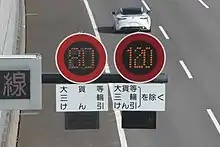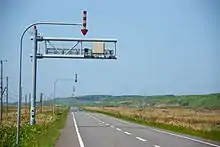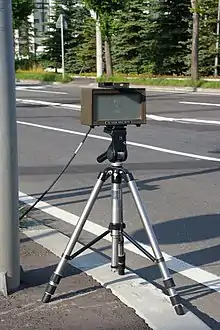Speed limits in Japan
Statutory speed limit in Japan defaults to 100 km/h (62 mph) for divided national expressways and 60 km/h (37 mph) for any other roads, unless otherwise posted.[1] The highest speed limit in Japan is 120 km/h (75 mph) on some sections of Shin-Tōmei Expressway (E1A) and Tōhoku Expressway (E4).[2] Urban two-way streets are usually zoned at 40 km/h (25 mph) or less.[3]

Summary
Statutory maximum speed limits of 100 km/h (62 mph) applies on divided national expressways and 60 km/h (37 mph) on other roads. There are no separate urban or rural statutory limits. Urban and rural limits are set by zoning rather than statute. Statutory speed limits for heavy trucks with GVWR over 8 t (17,640 lb), trailers and three-wheelers are restricted to 80 km/h (50 mph) on divided national expressways.
Implementation of speed limits in Japan can be summarized as:
- regulatory speed limits of 30 km/h (19 mph) on residential streets and 40 km/h (25 mph) are common for urban two-lane roads.
- regulatory speed limit of 40 km/h (25 mph) or 50 km/h (31 mph) is common in rural areas due to rugged mountainous terrain.
- regulatory speed limit cannot be set higher than 60 km/h (37 mph) for any streets with an at-grade intersection, or where pedestrians or cyclists are permitted.
- undivided expressways have a limit of 70 km/h (43 mph).
- variable speed limits are in effect on most national expressways.
- emergency vehicles are not exempt but have speed limit of 80 km/h (50 mph) on most roads and 100 km/h (62 mph) on divided national expressways, unless higher speed limit is posted. Police vehicles are exempt during speeding enforcement.
Enforcement


Speed camera
A threshold for speed cameras in Japan is set at a minimum of 40 km/h (25 mph) above the limit on an expressway and a minimum of 30 km/h (19 mph) above the limit on other streets, where drivers will face criminal charges instead of traffic infractions. This is due to legal precedents dating back to 1969 restricting police from filming an individual unless a criminal offence is immediately being committed.[4]
Police enforcement
Although there is no official tolerance for exceeding the speed limit, most drivers in Japan tend to drive over the speed limit. Police enforcement varies depending on the jurisdiction, officers, traffic flow and types of street, but 20 km/h above the speed limit on an expressway and 15 km/h above the limit are generally tolerated on other streets.[5] Some jurisdictions, such as Tokyo Metropolitan Police, releases the list of traffic enforcement locations on their websites.[6]
Speed limit guidelines
In Japan, speed limit cannot be set higher than 60 km/h (37 mph) for any streets with at-grade intersection or where pedestrians or cyclists are permitted. In other words, the street must be converted to controlled-access highway with costly grade separation to achieve speed limits higher than 60 km/h (37 mph). There is also major distinguishment between surface streets (一般道路, ippan dōro) and expressways (高速道路, kōsoku dōro) when setting speed limits and different criteria are used.
Although some surface streets such as viaducts, trunk and bypass roads are built to expressway standards, many are not legally classified as expressways and are typically distinguishable by the colour of direction signs: surface streets use blue direction signs while expressways use green signs.
Surface streets
Speed limits for surface streets are set within ±10 km/h (6.2 mph) of the reference speed limit below. Reference speed limits do not apply to expressways.
| Class | Area | Travel Lanes | Divided | Pedestrian Volumes | 85th Percentile Speed[9] | Reference Speed Limit | Factors affecting the Reference Speed Limit (Reason for deviating from 85th speed) |
|---|---|---|---|---|---|---|---|
| 1 | Urban | 2 lanes | - | High | 51.9 km/h | 40 km/h | Urban and high pedestrian volumes |
| 2 | Low | 57.1 km/h | 50 km/h | Urban | |||
| 3 | 4+ lanes | Yes | High | 59.0 km/h | 50 km/h | Urban and high pedestrian volumes | |
| 4 | Low | 64.1 km/h | 60 km/h | Urban | |||
| 5 | No | High | 58.7 km/h | 50 km/h | Urban, high pedestrian volumes, and undivided | ||
| 6 | Low | 63.9 km/h | 50 km/h | Urban and undivided | |||
| 7 | Rural | 2 lanes | - | High | 58.2 km/h | 50 km/h | High pedestrian volumes |
| 8 | Low | 63.3 km/h | 60 km/h | Maximum speed allowed by legislation | |||
| 9 | 4+ lanes | Yes | High | 65.3 km/h | 60 km/h | Pedestrian | |
| 10 | Low | 70.4 km/h | 60 km/h | Maximum speed allowed by legislation | |||
| 11 | No | High | 65.0 km/h | 50 km/h | High pedestrian volumes and undivided | ||
| 12 | Low | 70.1 km/h | 60 km/h | Undivided | |||
|
30 km/h (in principle) |
20 km/h limit may be set on case by case basis for the following:
| |||||
|
70 km/h or 80 km/h (in principle) |
For speed limits 70 km/h and above, the road should be closed to pedestrians, cyclists, and mopeds in principle. | |||||
Definitions
| |||||||
Expressways
Speed limits for expressways are set at 100 km/h (62 mph) or the lowest adaptation speed derived from each expressway design speed criteria below.[8] Intercity expressways typically have higher speed limits, while urban expressways within major cities often have 60 km/h (37 mph) limits and two-lane expressways, typically in rural and remote areas, have 70 km/h (43 mph) limits for undivided and 80 km/h (50 mph) limits with physical separation.
Most expressways outside of cities have active variable speed limit signs and maximum speeds are lowered according to road conditions such as congestions, accidents, constructions and severe weather. When the statutory speed limits are in effect on national expressways, variable speed limit signs are left blank to indicate the statutory speed of 80 km/h (50 mph) for heavy trucks and 100 km/h (62 mph) for other vehicles. Two sets of variable speed limit signs are installed when the regulatory speed exceeds statutory speed of 100 km/h (62 mph) on national expressways or 80 km/h (50 mph) on other roads to regulate the maximum speed of trucks, trailers and three-wheelers to 80 km/h (50 mph).
| Curve Radius (m) | Adaptation Speed | Design standard | Exceptional | ||||||
|---|---|---|---|---|---|---|---|---|---|
| Superelevation (%) Inclusive-Exclusive | |||||||||
| 0 - 1 | 1 - 2 | 2 - 3 | 3 - 4 | 4 - 5 | 5 - 6 | 6 - 7 | Curve radius (m) | ||
| 1134 | 1031 | 945 | 872 | 810 | 756 | 709 | 120 km/h | (710) | (570) |
| 716 | 656 | 606 | 562 | 525 | 492 | 463 | 100 km/h | (460) | (380) |
| 420 | 388 | 360 | 336 | 315 | 296 | 280 | 80 km/h | (280) | (230) |
| 218 | 202 | 189 | 177 | 167 | 157 | 149 | 60 km/h | (150) | (120) |
| 141 | 131 | 123 | 116 | 109 | 104 | 98 | 50 km/h | (100) | (80) |
| 84 | 79 | 74 | 70 | 66 | 63 | 60 | 40 km/h | (60) | (50) |
| 47 | 44 | 42 | 39 | 37 | 35 | 34 | 30 km/h | (30) | |
| 21 | 20 | 19 | 17 | 17 | 16 | 15 | 20 km/h | (15) | |
| Sight distance | Adaptation Speed |
|---|---|
| 210 m ≤ | 120 km/h |
| 160 m - 210 m | 100 km/h |
| 110 m - 160 m | 80 km/h |
| 75 m - 110 m | 60 km/h |
| 55 m - 75 m | 50 km/h |
| 40 m - 55 m | 40 km/h |
| 30 m - 40 m | 30 km/h |
| < 30 m | 20 km/h |
| Combined Gradient | Adaptation Speed |
|---|---|
| Below 10% | 120 km/h |
| 10% but below 10.5% | 80 km/h |
| Above 10.5% but below 11.5% | 50 km/h |
| Slope | Adaptation Speed |
|---|---|
| 5% and below | 120 km/h |
| Above 5% but less than 6% | 100 km/h |
| Above 6% but less than 7% | 80 km/h |
| Above 7% but less than 8% | 60 km/h |
| Above 8% but less than 9% | 50 km/h |
| Above 9% but less than 10% | 40 km/h |
References
- "The Order for Enforcement of the Road Traffic Act (Japanese)". Government of Japan. Government of Japan. Retrieved 22 February 2017.
- "新東名高速道路における最高速度120キロの試行開始について" (in Japanese). 2 February 2019. Retrieved 1 March 2019.
- "Driving in Japan". Japan-Guide.com. Japan-Guide.com. Retrieved 22 February 2017.
- 刑集第23巻12号1625頁
- 速度規制の目的と現状 P.12 - National Police Agency of Japan
- 警視庁 公開交通取締り - Tokyo Metropolitan Police Department
- National Police Agency; 規制速度決定の在り方に関する調査研究検討委員会 (March 2009). 平成20年度 規制速度決定の在り方に関する調査研究 報告書 (PDF) (Report). pp. 1, 10, 12–13, 15–18, 27, 36, 39, 41–51.
- 警察庁交通局 (2017-04-24), 交通規制基準 (PDF), p. 120-128
- National Police Agency; 規制速度決定の在り方に関する調査研究検討委員会 (March 2009). 平成20年度 規制速度決定の在り方に関する調査研究 報告書 (PDF) (Report). p. 8.
表 2-4 数量化I類による計算結果(85 パーセンタイル速度)
- 警察庁交通局; 交通規制課 (2014-04-02), 最高速度規制の点検・見直し等の更なる推進について(通達) (PDF), p. 3
- 生活道路におけるゾーン対策推進調査研究検討委員会 (March 2011). 生活道路におけるゾーン対策推進調査研究報告書 (PDF) (Report). p. 23.
.svg.png.webp)
.svg.png.webp)